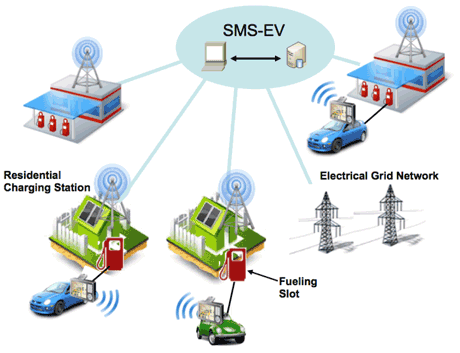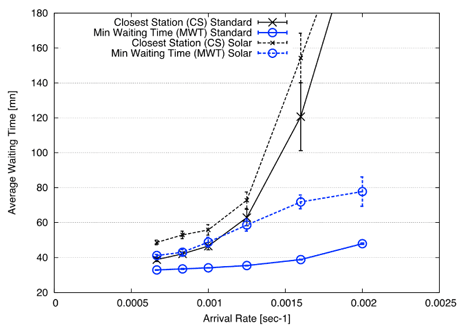by Raffaele Bruno, Luca Valcarenghi, Molka Gharbaoui and Barbara Martini
Concerns about the impact of climate change mandate the drastic reduction of green house gas (GHG) emissions through the increased utilization of renewable energy sources (eg wind or solar energy), as well as hybrid and electric vehicles (EVs). To achieve this goal we outline a smart management system for community-wide public charging infrastructures, which can foster the market penetration of EVs by effectively complementing home-based charging while coping with the power fluctuations of renewable energy sources.
One of the main targets for smart cities is a “new environmentally conscious form of urban living”, which entails a more intelligent use of locally generated renewable energy and the integration of sustainable and greener sources into the large-scale car fuelling system [1]. Liberalization and deregulation of electricity markets mean that citizens are no longer passive consumers of electricity provided by large-scale distribution systems, but active market players and micro-producers at individual and community levels. Moreover, electric cars have gained popularity over the last two years thanks to increasing concern about the environment, public health, the unsustainable nature of fossil fuel use, and the release of a handful of affordable electric vehicles (EVs).
Several infrastructure problems stand in the way of widespread use of EVs. While EVs could be charged using conventional household electrical outlets (albeit with significant charge delays), we are not yet close to developing a large-scale public charging infrastructure, and such an infrastructure will be costly to build. Moreover, while the EV technology enables the shift from fossil fuel dependent combustion engines to electrical engines, much of the electricity used to recharge the batteries will still be produced via unsustainable methods. Finally, with increased use of EVs, the demand for electricity will soar, and, if charging is unregulated, will be accompanied by the risk of grid overload.
We argue that to address the above technical challenges there is a need for smart management systems for electric vehicle recharge (SMS-EV), which could jointly and autonomously control EV charging and distributed energy resources (ie, renewable sources) at a community/city-wide level. Specifically, we envision urban areas in which public charging infrastructures are built upon an interconnected mesh of residential/commercial charging docks, or charging stations (an illustrative example is provided in Figure 1). The SMS-EV will need to: (i) ensure a balanced usage of the electrical infrastructure minimizing the impact of EVs on grid reliability and peak demands; (ii) improve the sustainability of the EV charging infrastructure by optimizing the utilization of locally generated renewable energy; and (iii) maximize user satisfaction with the EV charging service (eg, minimizing EV charging times). This vision entails the use of emerging wireless networking paradigms (eg, VANETs) for information dissemination to achieve: good coverage without dense deployments, scalability, communication reliability, and fast and incremental deployability with a low initial investment. Most importantly, the SMS-EV must feature an intelligent service layer capable of providing customized information and services to drivers while ensuring an efficient use of energy resources at individual and community levels.

Figure 1: Example of a SME-EV architecture
We are currently exploring the potential benefits offered by the SMS-EV [2], and preliminary results are reported in Figure 2. The considered scenario features an SMS-EV that applies two different policies for assigning an EV to charging stations when a new charging service request is used by an EV: (i) closest station policy (CS), which minimizes travelling times by assigning an EV to the closest charging station; and (ii) minimum waiting time policy (MWT), which assigns an EV to the station that minimizes the charging delay taking into account the time to complete the charging of other EVs currently present at each charging station. Intuitively, another essential factor that may affect the system performance is the type of power resources deployed in SMS-EV. Specifically, we consider two types of power sources: (i) standard grid-based power sources, which can be assumed to have a constant power production profile during the day; and (ii) solar panels, which are known to suffer from short-term variability of their output power due to changing atmospheric conditions even during high insolation daytime hours (in Figure 2 variability is assumed to be 50% of clear sky nominal power). Figure 2 reports the observed charging delays versus the arrival rate of charging requests for the case of a charging infrastructure deployed in 5x5 grid road network, in which each block size is 1km x 1km. The results show that the MWT policy is beneficial because it reduces the average waiting time with respect to the CS policy for both the types of power sources. It must also be noticed that for high request arrival rates the MWT policy combined with the utilization of solar power outperforms the CS policy even if utilizes traditional power sources. Furthermore, these results clearly indicate that there is a need for more sophisticated charging strategies that take into account vehicular mobility as well as the temporal variability of PV output power.

Figure 2: Comparison of charging times with different policies for charging station selection and different mixes of power sources
Link:
http://cnd.iit.cnr.it/index.html
References:
[1] C. Rissen et al: “Electric Vehicle Charging Solution for Smart Cities”, Hitachi Review, vol. 61, no. 1, Feb. 2012
[2] M. Gharbaoui et al: “Effective Management of a Public Charging Infrastructure through a Smart Management System for Electric Vehicles”, in proc. IEEE ENERGYCON-STS’12, Florence, Italy, 2012.
Please contact:
Barbara Martini
CNIT, Pisa, Italy
E-mail:
Raffaele Bruno, Marco Conti
IIT-CNR, Italy
E-mail:
Luca Valcarenghi, Molka Gharbaoui, Piero Castoldi
Scuola Superiore Sant’Anna, Italy
E-mail:
{jcomments on}











